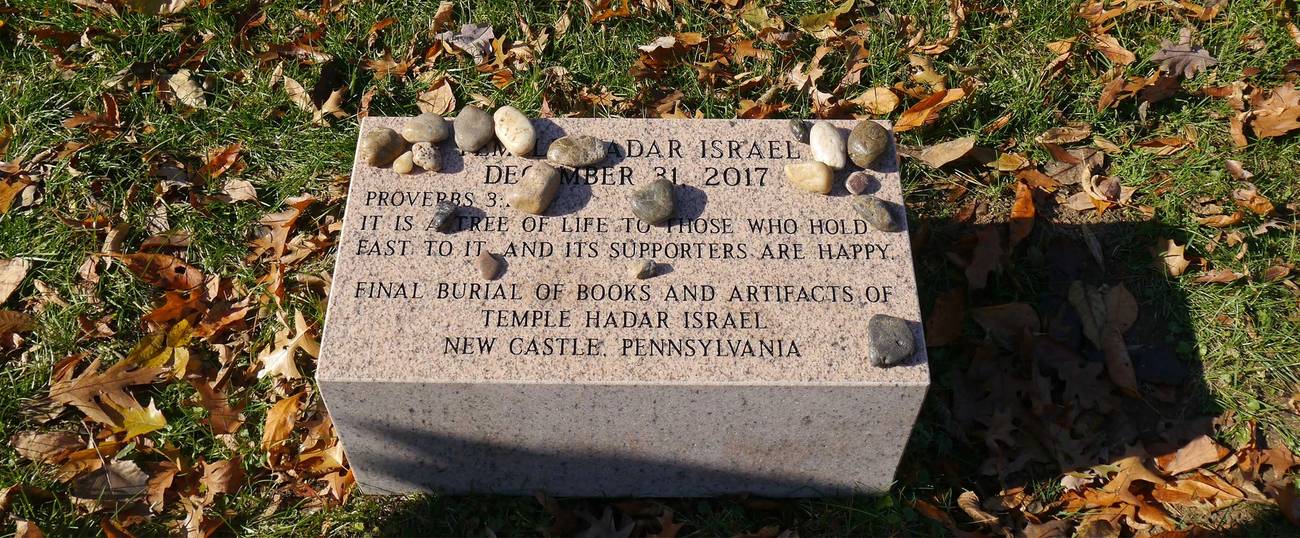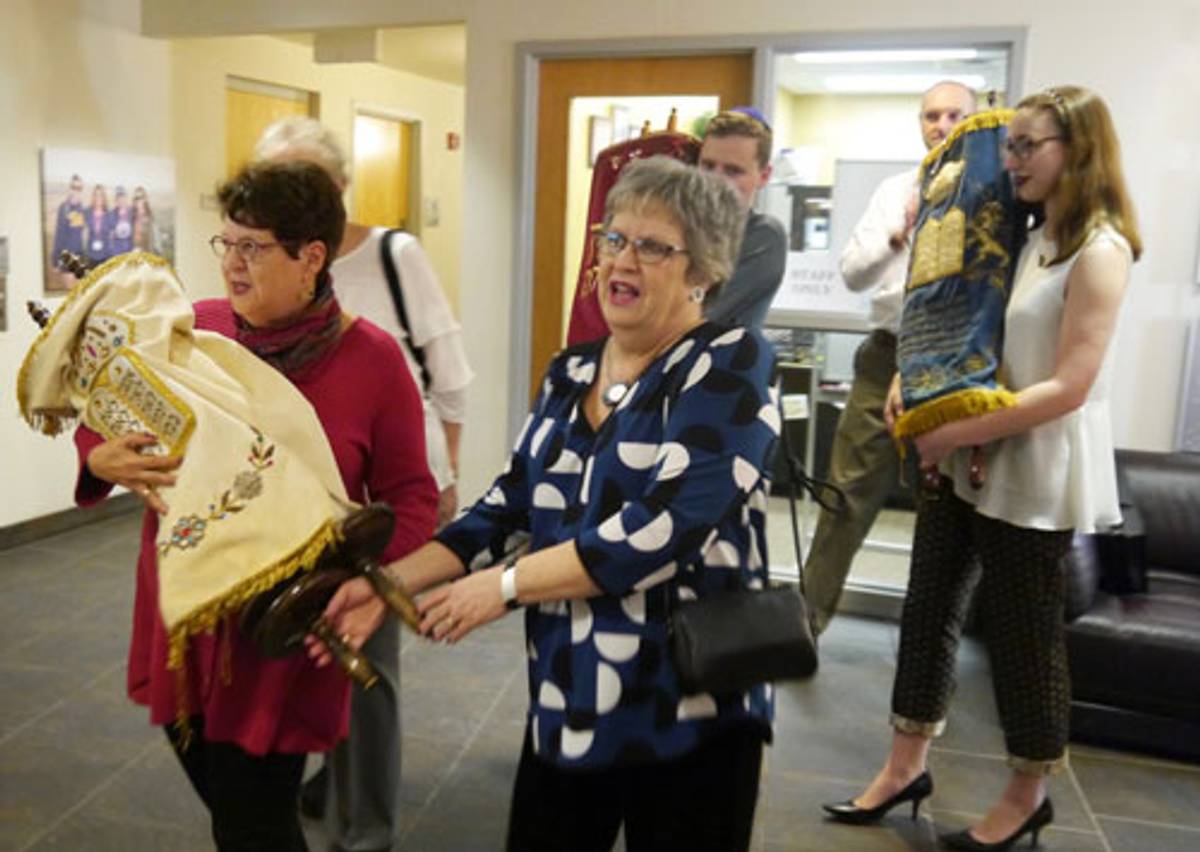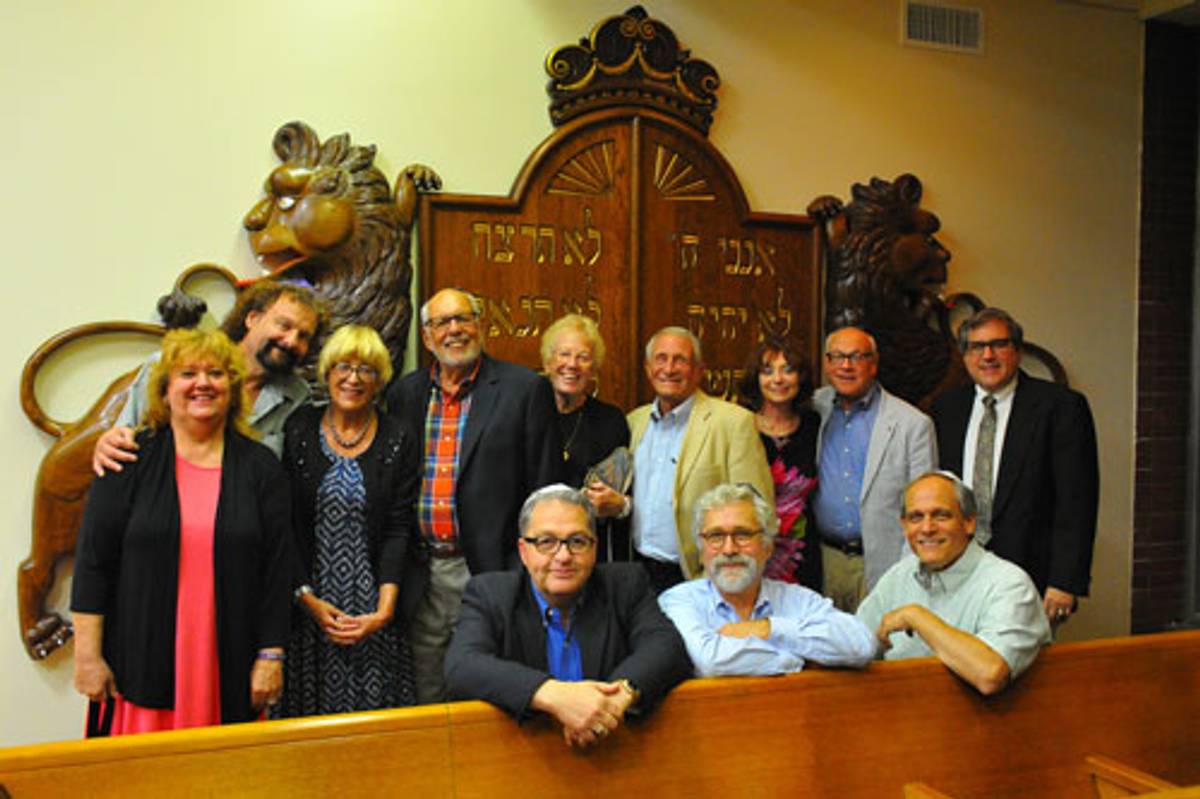Saying Kaddish for a Rust Belt Congregation
When Temple Hadar Israel in New Castle, Pennsylvania, closed its doors, most of its ritual objects were disbursed to other congregations. What was left was buried in a cemetery.




On a Sunday morning in November in New Castle, Pennsylvania, 18 individuals gathered in a Jewish cemetery for an unveiling ceremony. American Jews customarily hold this sort of event a year after a person dies to mark the installation of their gravestone, and to share memories of the deceased. This event was different because it marked the unveiling of a gravestone for a congregation, or—more precisely—for its ritual objects.
A few minutes before 11 a.m., the cars began arriving. Down the hill, around the bend into the little cemetery, friends parked under the clear, sunny sky near the spot where they had gathered nearly one year earlier, when their congregation formally disbanded and they held a burial ceremony for many of their sacred items. A flat granite slab had now been installed beside the muddy burial site, where grass had still not taken root. The text, etched into the slab’s surface read: “Final burial of books and artifacts of Temple Hadar Israel.”
The word “final” signifies the end of the Jewish history in New Castle, Pennsylvania. Jews settled here at the turn of the last century along with a wave of other European immigrants who arrived in Western Pennsylvania, drawn by a booming economy. The Jews who came to this part of the state mostly concentrated in Pittsburgh, where some 13,000 settled by 1900; the city’s Jewish population peaked at 55,000 in 1930. Others made their homes in the small towns that radiated out from this urban center.
At their height in the 1950s and ’60s, more than 40 small towns—spreading east to the Allegheny Mountains, and west to the Pennsylvania-Ohio border—were home to thriving Jewish communities. Some, like New Castle, grew large enough to support two synagogues, Temple Israel (Reform) and Hadar Israel (traditional). Then with deindustrialization, came economic decline. Grown children left their hometowns and did not return, leaving aging and dwindling populations behind.
New Castle’s Jews responded by merging their two congregations into one. The newly formed congregation was named Temple Hadar Israel, and affiliated with the Conservative movement. Still, the consolidation only temporarily solved the problem of shrinking numbers. By 2017 the congregation’s members agreed that there were simply not enough of them to continue functioning.
Today fewer than 10 small-town synagogues remain open in Western Pennsylvania’s Rust Belt. With so many shutting their doors, Temple Hadar Israel is not alone in facing a glut of sacred items, which they are scrambling to pass on to others who might carry on their communal legacies.
*
New Castle’s congregation created rituals to ease them through this weighty task. Beginning in 2015, when members of Temple Hadar Israel found it increasingly difficult to gather a minyan for prayers, they began discussing plans for winding down operations. The group, which has come to see itself much like a living organism that is born, grows, withers, and eventually dies, engaged in a deliberate end-of-life planning process. They enlisted Jewish Community Legacy Project, which helps dwindling congregations ensure their legacies, catalog their histories, and responsibly divvy up their assets.
Temple Hadar Israel sold its building in 2015, although members continued to meet in the sanctuary until disbanding two years later; the congregation divested of its movable property, including its eight remaining Torah scrolls. New homes were found for each with the help of JCLP, which keeps a list of Jewish institutions in need of a scroll, and helps to identify those institutions that may be in a position to donate. Three went to summer camps, one to a Reform temple in South Carolina, one to a Progressive congregation in Warsaw, one to a Houston synagogue that suffered damage in Hurricane Harvey, and one to a tiny community in Indonesia.
*
On a Saturday morning in February 2018, Temple Hadar Israel members boarded a rented bus in New Castle, and took the hour-long ride to Pittsburgh to present their last remaining Torah in a formal, public ceremony. It was transferred to Pittsburgh’s Hillel Jewish University Center, which serves as a social and religious hub for Jewish students at Carnegie Mellon University, the University of Pittsburgh, Duquesne University, and a few of the city’s other small schools.

A group of nearly 200 students, university administration, and guests gathered in the Hillel building for the event. The New Castle elders lined up at the front of the large social hall, passed the Torah from one to the next, and then into the hands of Hillel’s young leaders. Deena Mirow Epstein, a former member of the New Castle congregation who had a special family connection to the Torah, rose before the crowd to recount the details of its layered past.
Reading a text she had prepared by piecing together information from old newspaper clippings, notes from her parents, and her own memories, Epstein told a story that began almost a century ago, in a small town on the other side of the Atlantic.
Before immigrating to New Castle, Epstein explained, her parents lived in Suwalki, Poland, once home to some 6,000 Jews. In the late 1930s, just before the Nazi invasion, the couple escaped to the United States. Most of their relatives who stayed behind were killed.
But a cousin, Nochem Adelson, was among the very few who survived. He returned to Suwalki after the war and rebuilt his life there. Thirty years passed. Then, while renovating his old farmhouse, Nochem opened a wall and to his surprise, a Torah scroll wrapped in a box came tumbling out. He understood the significance of the Torah, but did not know what to do with it. In Suwalki, there were not even enough Jews for a minyan to read from it. He contacted his cousins Janet and Joseph (Epstein’s parents) in the United States, thinking they could use it.
By the time the couple received this news, they had two grown daughters, Joseph owned a thriving jewelry business, and they lived comfortably among New Castle’s vibrant Jewish population. Still, the near total loss of the Jewish community of their youth had left a terrible void. Some measure of comfort was offered when they read of Nochem’s discovery.
Through bribery and some goodwill, Janet and Joseph found a way to get the Torah smuggled out of communist Poland and into their hands. When it arrived in New Castle in 1974, the Torah was welcomed into their synagogue amid celebration and tears. Information about this event was preserved in New Castle News. “Cry, cry, cry, and cry,” Janet told a reporter, “Everybody was very emotional.”
Now, Epstein was emotional as she finished her speech and watched one of the students chant from that very scroll. “My mother would have loved to see all this,” she told me, wiping her eyes. And Sam Bernstine, Temple Hadar Israel’s former president chimed in: “We have no children in New Castle to pass on our legacy,” he said, but here on the University of Pittsburgh campus, “we know the youth will treasure it.”
*
A hefty wooden sculpture, once mounted on the wall of New Castle’s synagogue, tells a different story of the community’s past. Carved from wood, and standing about 5 feet high, two lions face each other, their eyes bulging and tongues extending out. Between their ornate paws, the pair holds a large set of tablets, upon which the Ten Commandments are engraved, and painted in gold.
Synagogue records, housed in the Rauh Jewish Archives of Pittsburgh’s Heinz History Center, indicate that the Young Ladies Benevolent Society of Tifereth Israel Synagogue (an earlier incarnation of Temple Hadar Israel) purchased the sculpture. On the occasion of the congregation’s move into a new building in 1909, the group dedicated it, and had it installed above the ark that housed the Torah scrolls.

Lions have long served as symbols of Jewish royalty and strength. They have been used across much of the Jewish world to decorate synagogue arks, textiles, floor mosaics, and even gravestones. But in the United States at the turn of the 20th century, they took on a new artistic style. Eastern European Jewish immigrants innovated a fresh visual vocabulary for their lion sculptures, influenced by their prevalent role as craftsmen in the carousel-horse industry (as illustrated in the 2007 American Folk Art Museum exhibition Gilded Lions and Jeweled Horses).
But synagogue aesthetics underwent a radical change in the post-WWII era. Tifereth Israel sold its 1909 structure and constructed a new, modern building. Contemporary design sensibilities could hardly accommodate the ornately sculpted lions. Nevertheless, the congregation did not abandon them.
Rather than placing them front and center, above the sleek new ark in the modern sanctuary, the congregation put the lions a bit out of the way in the social hall. On High Holidays, when the sanctuary filled with worshippers, the accordion wall that cordoned off the social hall was drawn open. Congregants who took seats in the overflow area could look up, and see the lions framing the holy ark from afar.
Artist Michael Kraus was one of those congregants. As a child, he spent long hours during many religious services contemplating the fierce lions, which seemed to be protecting God’s words between their paws. Later, their artistic influence seeped into some of his own sculptures, crafted of stone and bronze.
When Kraus—who has since moved to Pittsburgh—heard that his childhood synagogue would be closing its doors, he was concerned that the lion sculpture “would get left behind,” or “broken into pieces,” because its cumbersome size and weight made it difficult to move. But members of B’nai Abraham Congregation in Butler, Pennsylvania, 30 miles east of New Castle, ensured that their legacy would live on.
They raised funds and made arrangements to have it removed with a hydraulic lift, refurbished, and mounted in the back of their modest synagogue. At the dedication ceremony in August 2017, Kraus spoke about the sculpture’s history. Michal Gray-Schaffer, B’nai Abraham’s cantor, sang a piece of music she composed for the occasion, inspired by a verse in Genesis 49 that has Jacob blessing his son Judah by comparing him to a lion, “king of the beasts.”
*
For members of the now-defunct Temple Hadar Israel, great care and energy was put into creating transfer ceremonies for their Torah scrolls and lion sculpture. “Our bits and pieces are now scattered among other communities,” Bernstine reflected. But so many other objects, which had no biographies attached to them, were simply orphaned. With synagogues across the region shutting downs, museums, archives, and other congregations are simply uninterested or unable to adopt ubiquitous items like menorahs, religious books, prayer shawls, or memorial plaques.
Faced with the question of how to dispose of these, New Castle’s congregation turned to the Jewish custom of burying sacred objects. On Dec. 31, 2017, the day after their final Shabbat services, members and friends gathered in the Tifereth Israel Cemetery, where a pit in the ground had been opened. Deep inside, some 20 boxes nestled next to each other, containing prayer books, dedicatory plaques and unclaimed yahrzeit plaques, prayer shawls, and velvet textiles that had covered the Torah ark and the reader’s tables. Huddled around the deep hole, the group recited the Mourner’s Kaddish and delivered speeches akin to eulogies.
Lest the buried items simply be forgotten once interred, a stone was installed on the ground to mark them. At the unveiling ceremony this past November, Rabbi Howard Stein, who officiated, opened by explaining, “We are gathered to remember what has passed here and what continues to live in our memories.” He then read Psalm 121: “The Lord will guard your going and coming now and forever …” an appropriate text to recall the Jewish community’s arrival in New Castle more than 100 years ago, as well as to acknowledge its departure and scattering from this town today.
As the brief service came to an end, synagogue member Sybil Epstein placed a small smooth rock on the gravestone to mark her visit, then held up a tissue to her large glasses to catch a few tears. “We are the remnant, the last Jews here,” she declared, looking around at the little group. “But when we are gone, and people come to our cemetery to visit their ancestors, they will see our stone here. And they will know that we were a group that really cared, and mattered.”
***
Like this article? Sign up for our Daily Digest to get Tablet magazine’s new content in your inbox each morning.
Alanna Cooper serves as the Abba Hillel Silver Chair in Jewish Studies at Case Western Reserve University. She is the author of Bukharan Jews and the Dynamics of Global Judaism.